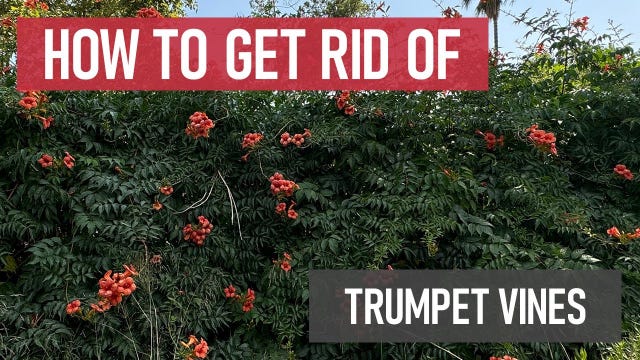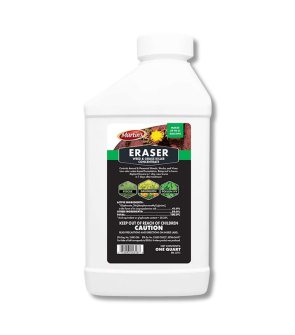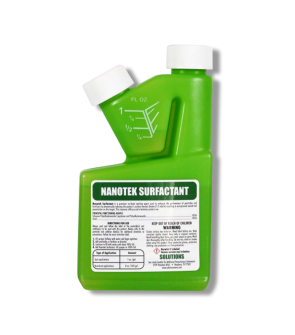Gain access to personalized product screening, the best pricing, rewards, and more!
Most Effective Products
Trumpet Vine Control: How to Get Rid of Trumpet Vine
This page is a general DIY guide for controlling trumpet vines. Using the products and methods suggested, you get control of trumpet vines. Follow this DIY article and use the recommended products; we guarantee 100% control of trumpet vine.
Trumpet vines, also known as cow-itch, cow vine, devil's shoestring, foxglove vine, hellvine, or trumpet creeper, are perennial broadleaf weed vines that attach to many surfaces. While beautiful, they are considered a nuisance since they quickly overtake structures and desired foliage.
This fast-growing perennial is pretty aggressive once established and can establish itself from any leftover root, seed, or wood. Many gardeners cultivate this plant, but they can overtake and choke out desired foliage, create cracks in brick or cement, and prevent soil from absorbing water. Additionally, direct contact can cause skin redness or swelling.
If left untreated, trumpet vines may weaken the structural support of buildings they grow along and render desired ornamentals dead from a lack of moisture. Refer to our DIY guide to learn how to prevent and control trumpet vines cost-efficiently.
Identification
Before proceeding with a treatment program, you need to be certain that you are dealing with a trumpet vine infestation. Careless identification can lead to using the wrong treatment methods, which can waste time and money. Below are the following characteristics to help you understand what trumpet vines look like.

- Trumpet vines are woody perennial vine weeds with large clusters of narrow 3" trumpet-shaped yellow, orange, or red flowers. They also have 5 lobes.
- With its stems, it can easily climb over surfaces to reach a height of 30 to 40 feet. In more open spaces or when allowed to establish itself as a tree, it will grow between 20 and 40 feet tall.
- Leaves are compound, dark to bright green, and ovate-shaped with serrated margins and pointed tips.
- Seeds are produced in large, flat pods that start soft and green, then harden and turn brown. Eventually, these pods will split open to reveal numerous seeds.
Use the description and image above to help you correctly identify trumpet vines on your property. If unsure, contact us and send a photo of your weed through email or in person at one of our stores to help you identify the weed and suggest treatment options.
Inspection
Once it is confirmed that you are dealing with trumpet vines, you can move on to inspection. During this phase, you will locate areas where trumpet vines are thriving and observe the conditions allowing them to succeed. This information will help you in knowing where to focus your herbicide application.

Where to Inspect
Trumpet vines prefer to grow in wet to dry soils exposed to full or partial sun. They will grow in most average soils but are commonly found in clay, loam, and sand, with a pH range between 3.7 and 6.8.
Common sites for trumpet vines are woods, forests, the sides of buildings, retaining walls, rock piles, fences, large poles, trellis, and over other plants.
What to Look For
From June to September, trumpet vines will bloom and produce flowers. As they grow, these plants will cover existing foliage and sites with vast vines.
Treatment
After identifying trumpet vines and inspecting where they are most active in your property, you can begin to treat your area. Be sure to wear the appropriate personal protective equipment (PPE) before handling or applying any product.
Post-emergent herbicides containing glyphosate, triclopyr, or dicamba are most effective against trumpet vines.
In the southern United States, where most lawns have warm-season turf, we recommend using Fahrenheit Herbicide. In cool-seasoned turf or if your trumpet vines are growing vertically along concrete surfaces away from your desired plants, consider a product like Eraser 41% Glyphosate.
Keep in mind that Eraser is a non-selective herbicide that will kill any plant it is applied to or may drift to.
We recommend performing a stump treatment with Eraser 41% for more established trumpet vines that become trees.
Step 1: Mix and Apply Herbicides
Fahrenheit Herbicide is a water-dispersible granule herbicide that controls broadleaf and grassy weeds like trumpet vines (known as trumpet creeper on the label) in warm-seasoned turf.
For spot applications with Fahrenheit Herbicide, use 0.2 oz. of product per 1 gallon of water per 1,000 sq. ft.
We recommend using a non-ionic surfactant to enhance the performance of your herbicide. Nanotek Surfactant is a non-ionic surfactant that greatly enhances the penetration and coverage of herbicide and insecticide material.
Just mix 1 oz. of Nanotek Surfactant per 1 gallon of spray solution.
Eraser 41% Glyphosate is a non-selective herbicide that will control any foliage it is contacted to within sites such as but not limited to lawns, fences, and around buildings.
To remove trumpet vines with Eraser 41% Glyphosate, perform a spot treatment. Use 2 1/2 oz. (5 tbs) of Eraser 41% Glyphosate per 1 gallon of water per 300 sq. ft.
Measure the square footage of the treatment area to determine how much herbicide to use. To do this, measure the length and width of the treatment area in feet and multiply them together (length X width = square footage).
We recommend mixing and applying either herbicide in a handheld pump sprayer.
Be sure to mark the sprayer used for Eraser 41% Glyphosate for non-selective herbicide use. Only to prevent cross-contamination in the future.
To mix, pour half the water and add the measured amount of herbicide. Next, pour in the remaining half of the water and close the tank lid. Agitate the spray tank until the solution is evenly mixed.
Spot-treat any weed you find during your inspection. Use a fan or cone spray pattern to ensure the leaves are fully coated, and spray the weed to the point of wetting but not runoff.
To kill trumpet vines growing up a pole, fence, or mature tree trunk, cut the vine to a height of 3 to 4 feet and spray thoroughly covering the remaining vine.
If the trumpet vine is climbing a shrub or immature (green) tree trunk, cut it at the base close to the soil surface and treat it as directed for stumps or spray regrowth to avoid wetting the shrubs or tree trunk.
To do a stump treatment with Eraser 41% Glyphosate, you will need to cut the stump close to the soil surface. Make 4 to 5 nail holes into the stump.
Next, flood the stump with the undiluted product. Be sure to use this product within the next 5 minutes after cutting trees.
Step 2: Retreat if Necessary
When applied properly, affected weeds will turn yellow and begin to die. Trumpet vines treated with Eraser 41% Glyphosate may show signs of injury within 2 to 4 days, but total weed death may take up to 4 weeks.
Conduct follow-up applications with Fahrenheit Herbicide when 4 to 6 weeks have passed after application.
A second application can be made with Eraser 41% Glyphosate when 4 weeks have passed after application.
Applications are most effective when the plant is young and actively growing, before flower or seed production.
Prevention
Once trumpet vine has been eliminated from your property, you will need to implement preventative measures to ensure that it does not return.
- Pruning after trumpet vines have bloomed is essential to keeping them from spreading and reseeding. You can also cut the vine from the ground to help stop it from growing.
- Consistently rake or pick up fallen plant debris, as trumpet vines can regrow from fragments of the roots and leftover wood material.
- Completely remove the stumps of dead trumpet vines from the ground until the roots are exposed.
- Mow your grass at proper intervals to maintain a thick growing density. A lawn dense with taller trimmed grass can better choke out weeds and prevent them from establishing.
Key Takeaways
What is Trumpet Vines?
- Trumpet vines are woody broadleaf weeds with flowering vines that some consider aesthetic but can spread quickly.
How to Get Rid of Trumpet Vines
- To get rid of trumpet vines, we recommend using Fahrenheit herbicide mixed with Nanotek Surfactant or Eraser 41% Glyphosate.
Preventing Trumpet Vines Reinfestations
- Prevent trumpet vines from regrowing by pruning them early in their development and regular maintenance throughout your yard.













